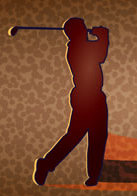19th Century Printing
Visitors to the Grandin Room hear the story and witness the printing of a 16-page section of the first edition Book of Mormon which was originally printed in Palmyra, New York, in the fall and winter of 1829-1830. Guest will see the setting of type and feel a replica of the original Acorn Hand Press.
As you look through the window into the E. B. Grandin Room, you'll see the printing shop much as it was in 1829. Bratt Grandin was the printer and publisher of the Wayne County Sentinel. Mr. John H. Gilbert, a master printer, assistant to Mr. Grandin, greets you at the door. In 1829 he handset the type for the 590 pages of the first edition Book of Mormon.
Mr. E. B. Grandin took on the task of printing the Book of Mormon. A few pages of manuscript as a specimen of the whole was submitted by Martin Harris. They agreed upon a 7 1/4 X 4 1/2 inch page. The text block would be in 21 1/2 picas by 43 lines. The body of the book was in small pica - that is 11 point solid set as on a computer by terms of today. At a trial setting, it was found out that it worked out to be about 2700 pieces of type per page.
But that is not all! While one form is in the press, one form is standing being proofed and corrected. A third form is being typeset, while the form already printed is being taken apart and the type being re-distributed to the type case. That is the rough equivalent of three forms of type being in use at all times - three times 43,000 pieces of type - maybe 130,000 pieces of type. So they needed lots of type! The lower-case 'e's make up about 10 percent of the total number of letters in a font. For this job, that's 13,000 'e's. Only about a third of those would be in the case at any one time.
The owner of the print shop in Palmyra, E. B. Grandin, quoted Joseph Smith a price of $3,000 to print five thousand copies of the Book of Mormon. Mr. Martin Harris, who was assisting Joseph Smith, promised to sell enough books to pay for the printing. He then gave Grandin a mortgage on his farm to guarantee payment upon completion. In August 1829, Mr. Grandin notified Harris that they were ready to print the book. Joseph Smith's brother Hyrum then brought the first installment of the manuscript, a group of 24 pages closely written on foolscap paper. He brought it to the print shop under his vest, with his coat closely buttoned over it.
It took seven months for master printer John Gilbert to hand set the 590 pages of the Book of Mormon, one letter at a time, upside down and backwards. Since the manuscript was written without punctuation it was left to Gilbert's talent to add punctuation as he set the type. The first edition Book of Mormon was delivered to Joseph Smith on March 26,1830.
For 400 years since Johann Gutenberg, the type for both newspaper and book publishing had to be set by hand, one letter at a time. After printing, a page was distributed back into the type case ready to be used for the next page. The Linotype machine Ottmar Mergenthaler invented in 1886 was called by Thomas Edison the "Eighth wonder of the world."
Prior to the invention of the Linotype, composing the words for just one page of a daily newspaper required almost 34 man hours. The Linotype reduced that to about 3 hours.
Mergenthaler created a comprehensive set of tiny brass type molds or matrices. Up to 1,100 of these matrices stand at attention in the overhead storage magazine waiting to be released by the operator's keyboard. The assembled line of matrices move to a spot in front of a pot of molten lead. At precisely the right moment a plunger forces molten type metal into a mold which has been aligned with the matrices, creating a "line of type." These matrices are then moved to the distributor mechanism, and automatically sorted out into the overhead magazine ready to be used again. A metal slug containing a line of type has been cast. These lines of type are then assembled into a form ready for printing. Notice on the composing stone adjacent to the Linotype the front page of a newspaper with columns of Linotype slugs composed ready for printing.

